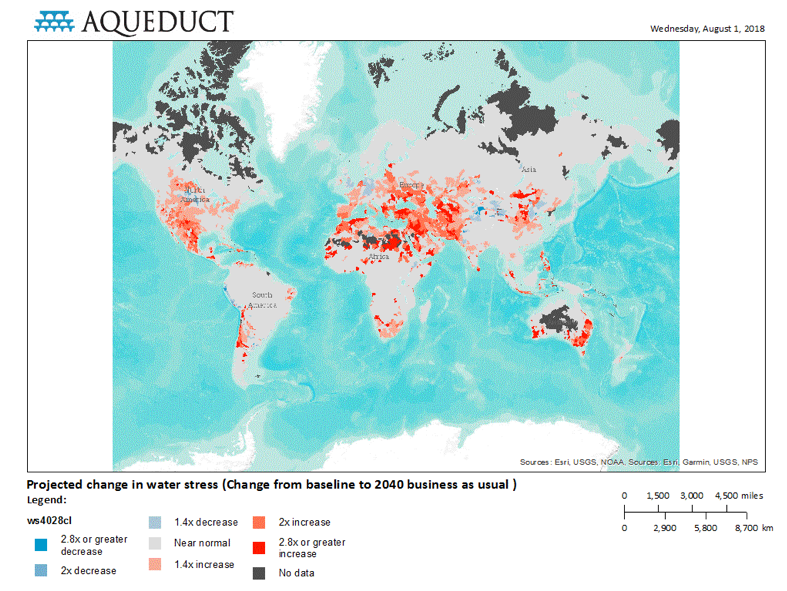
The water stress map shown in Figure 1, highlights the overlap between many of the regions expected to experience increased water stress by 2040 in a business as usual scenario. Many of these regions highlighted in red house large real estate markets, which stand to be adversely affected by water scarcity.
While traditional building efficiency benchmarks have centered on energy usage, increased concerns about water scarcity, water costs, and reputational risk, are pushing building owners and corporations to pay greater attention to water management across their portfolios as water usage becomes a greater material issue.
Metering: The First Step
Like the advancements made in building energy efficiency through metering and smart building controls, companies providing IoT – network-enabled devices allowing for instantaneous feedback and greater control, and data-backed solutions are leading the way to assist building owners with water efficiency. The often-used cliché of those working on energy management, “you can’t manage what you don’t measure”, has just as much merit in water management. Building owners looking to better manage their water usage must first understand their water usage.
Most buildings without advanced metering receive quarterly, whole-building water bills. Quarterly data makes it difficult to recognize unusual spikes in consumption and take the appropriate actions to identify and remedy issues. As a result, numerous cities across the world are pushing to retrofit smart water meters into buildings, allowing building owners to view granular water data for their properties in real time. Armed with real-time data, owners can utilize software to be alerted when costly water leaks arise in their buildings. A ULI report estimates that neglected water leaks in the US are responsible for 1.25 trillion gallons of water wasted annually – roughly equal to the consumption of Los Angeles, Miami, and Chicago, combined[3].
Innovations in water metering also make it possible for building owners to bill tenants for their water consumption. While in commercial office spaces this may not be significant due to the limited amount of water usage, in mixed-use commercial or multifamily buildings this may allow for more effective water management and savings through tenant behavior change. Many companies offering submetering integrated with online platforms for seamless billing, reducing the administrative costs of billing for property owners.
Along with more granular water data and tenant billing, building owners can also use water submeters for improved HVAC operation. Cooling towers, which are the second largest user of water in buildings, can benefit from submeters and help building engineers quickly identify leaks or water loss in the cooling process. In addition to metering the water usage itself, water chemistry can also be closely monitored to minimize mineral buildup and maximize the number of times water can be recycled through the system[4].
Moving Beyond Metering
In properties with significant water usage for landscape irrigation, owners are harnessing technology to better manage landscape watering through improved and informed scheduling. The new age of smart irrigation controllers factor in future weather forecasts and soil moisture levels to optimize watering scheduling and prevent overwatering and minimize evapotranspiration; which is the loss of water due to weather variables such as solar radiation, temperature, humidity, and wind. Smart controllers alone are estimated to reduce water usage by 15% compared to manual or clock timer irrigation [5]. When coupled with assistance from a landscape architect to design with primarily native plant species, which require less water to survive, even greater water savings can be realized.
Water reuse and recovery technologies such as cisterns and rain barrels are not necessarily new, however, improved controls and integration into building infrastructure may now allow this water to be reused on site for more than just irrigation purposes. In Washington, DC, the city’s revolutionary stormwater credit trading system, has real estate owners and developers paying greater attention to their on-site stormwater management. Buildings are incentivized to manage additional stormwater on site, as the stormwater retention credits (SRCs) generated from excess stormwater management, can be traded on an auction-like market created by DC’s Department of Energy and Environment[6].
Commercial real estate has the opportunity to lead the way when it comes to water conservation. Many buildings have already addressed the low hanging fruit by replacing faucets and toilets with low flow equivalents. In order to build upon this progress owners will need to plan for future water projects. Owners can utilize available technology in water metering, monitoring, and control technology to more effectively manage water usage and reduce operating expenditures while mitigating future risk related to water scarcity and strengthening their company’s reputation.
[1] https://www.un.org/waterforlifedecade/scarcity.shtml
[2] https://www.wri.org/our-work/project/aqueduct
[3] https://www.greenbiz.com/blog/2010/06/08/triple-threat-coming-water-crisis
[4] https://www.epa.gov/sites/production/files/2017-01/documents/ws-commercial-factsheet-offices.pdf
[5] https://www.epa.gov/sites/production/files/2017-02/documents/watersense-at-work_final_508c3.pdf
[6] https://doee.dc.gov/src
This article is written by Amit Paul, CodeGreen Solutions


